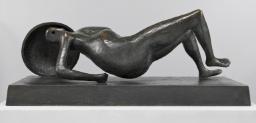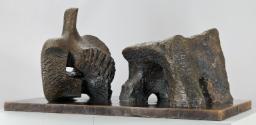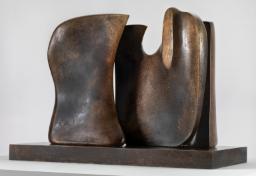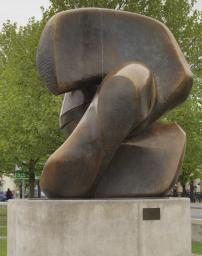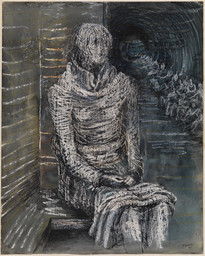Ambivalence and Ambiguity: David Sylvester on Henry Moore
Martin Hammer
David Sylvester was a prominent commentator on Moore’s work in the post-war years, producing extended critical accounts, which sometimes accompanied the exhibitions of Moore’s work he curated, and shorter reviews. As explored here, the ambiguous bodily and sexual associations of Moore’s work proved a consistent theme in his writings on the artist over a period of many decades.
David Sylvester (1924–2001) was among the most influential British art critics of his day and a key player in the British art world from the 1950s. He was also the most high profile commentator on Henry Moore’s art, writing several essays and exhibition reviews. Importantly, he also curated, and compiled catalogue texts for, a number of Moore exhibitions, helping to shape public reception of the sculptor’s work. Sylvester also drew Moore into his trademark project of broadcasting, and then publishing, interviews with artists, a genre of art writing that exploited the new availability of the portable tape recorder and of which Sylvester was one of the pioneers. Overall, his engagement with Moore was matched only by his concurrent immersion in the work of Alberto Giacometti and Francis Bacon, and later on, as a more art historical exercise, by his authorship of the multi-volume catalogue raisonné of the surrealist painter René Magritte (he later confessed that Magritte was not really his ‘type’).1 Even after Moore’s death in 1986, Sylvester continued his involvement with the work and its public presentation, and towards the end of his own life he wrote about their dealings with one another in texts intended for inclusion in an autobiography.2
Sylvester’s last reflections are no bland celebration of either Moore or his own activities. The typed drafts among his papers convey his acknowledged ‘ambivalence about Moore’s work and position’.3 On a personal level, he regarded the artist as ‘the ideal father which my own father had failed to be’, but conceded that his ‘relationship with Henry Moore was as full of contradiction as a relationship with a parent’.4 He further commented, touchingly, that ‘my affection for him was such that when we were talking my eyes were usually close to tears’.5 Sylvester recalled that he had initially believed Moore to be ‘one of the greatest artists of the twentieth century, along with Picasso and Paul Klee’, which was ‘quite an orthodox opinion in Britain at that time’, and indeed, to a surprising degree, internationally.6 However, this assessment faded quite soon: ‘within four years of our first meeting I had ceased to be among those who placed him in the first rank of twentieth century artists, and as time went on felt increasingly that a high proportion of his work was misbegotten, largely because it was engendered by flattery or payment from dubious sources, as I sometimes said in print’.7 Sylvester confessed that he had been ‘painfully embarrassed’ by Moore’s ‘constant readiness to talk about himself in the same breath as Michelangelo’, and also by his growing ‘thirst for honours’ during the latter stages of his career.8 Moore’s long-term reliance on assistants, and ready willingness to be distracted by ‘an insistent visit from some American collector and his wife’, contrasted with Giacometti, Sylvester’s ‘existentialist hero’, and the ‘saintly knight who had come without armour to redeem art from facility and commercialism’.9 Notwithstanding such ambivalence and disappointments, Sylvester ‘went on being heavily involved in studying and promoting his art’.10 This admission sounds rather grudging and opportunistic. As we shall see, however, the unpublished chapter may understate the extent to which private reservations were offset by a genuine commitment and enthusiasm that come through at times in Sylvester’s commentaries on Moore’s production.
The typescript immediately establishes the key point that Sylvester was twenty-six years younger than Moore. When he started to engage with the sculptor’s work, during the war years, Sylvester was around twenty, the age of a student had he chosen to follow that path. Moore was then well established as the leading British modernist artist, with a major body of sculpture behind him, and, more recently, the drawings of mining and of people sheltering in underground stations he had produced for the War Artists scheme. These had engaged large, appreciative audiences in wartime Britain, reaching beyond the more avant-garde circles in which his work had been admired and collected in the 1930s. Moore’s work had also been extensively exhibited in Britain and aboard, attracting a considerable body of critical literature, including Geoffrey Grigson’s Penguin Modern Masters study of 1944 and the richly illustrated monograph with an introductory essay by Herbert Read, the leading critic of the pre-war generation, which also first appeared in 1944. Whereas young critics will often seek to promote under-appreciated artists through journalistic or polemical catalogue texts and eventually essays for monographs and exhibition catalogues (one might think of Clement Greenberg on Jackson Pollock, Michael Fried on Anthony Caro, or indeed Sylvester himself on Francis Bacon), this was hardly the case here. Moore no longer required that kind of pump-priming advocacy, while Sylvester, for his part, appears simply to have needed to get out of his system an ardent, youthful enthusiasm for Moore’s work.
It was Read’s monograph, together with Grigson’s book, that prompted a book review by Sylvester in Tribune, the left-wing magazine where George Orwell was literary editor.11 For Sylvester, the ‘one limitation’ of Read’s introductory essay was the absence of ‘analysis of specific works’, a fair observation and an intimation of the direction of his own subsequent commentaries. Under the name Anthony Sylvestre, he had already published an essay in 1944 in an obscure, Oxford-based Catholic magazine,12 and these two early efforts were notable for their tortuous style and tone of unabashed admiration. Moore was ‘the greatest living sculptor’, according to the essay, on account of his ‘profoundly three-dimensional sensibility’ (especially apparent in the Northampton Madonna and Child 1943–4), while in the review Sylvester asserted that Moore is ‘with the exception of Picasso, the greatest artist since Cézanne’. This was ‘an objective judgement’ and Sylvester went even further, asserting that ‘the well-known Four Sleepers in the War Artists’ Exhibition is certainly not inferior to any art produced with pencil or pen since Raphael’.13
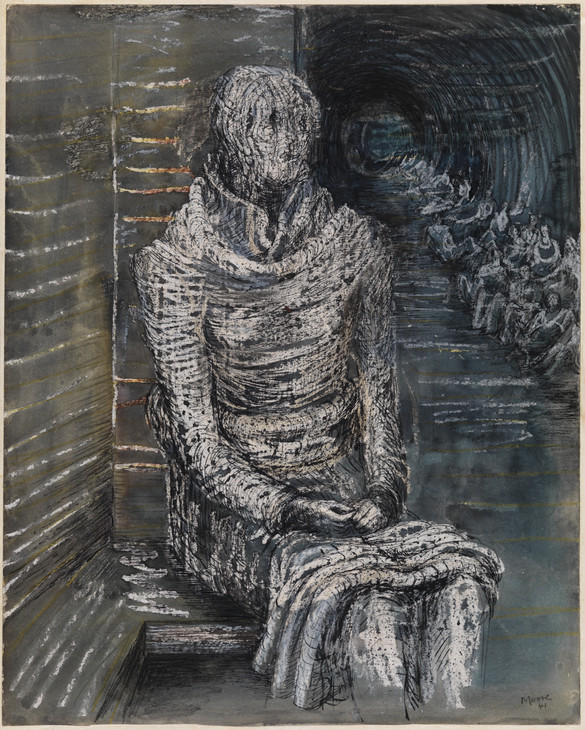
Henry Moore OM, CH 1898–1986
Woman Seated in the Underground 1941
Gouache, ink, watercolour and crayon on paper
support: 483 x 381 mm
Tate N05707
Presented by the War Artists Advisory Committee 1946
Fig.1
Henry Moore OM, CH
Woman Seated in the Underground 1941
Tate N05707
The two men’s direct personal and professional relationship began with Moore responding with an appreciative letter in response to Sylvester’s Tribune review. Moore may have been simply flattered and impressed by the young critic’s eloquence, but for Sylvester ‘this was the nearest thing I had yet received to a message from God’.16 They subsequently met and developed a friendly rapport, which a couple of years later led to an invitation to Sylvester, over lunch, to act as the sculptor’s secretary. The arrangement was to start in spring 1948, once Sylvester was back from an extended stay in Paris.17 The secretarial role ceased after a few months, on the grounds that they were spending too much time talking, which meant Sylvester interrogating Moore but also ‘coming to resist his views and neither of us could resist an argument’, while what the artist needed, of course, was someone efficiently to type up his correspondence and so on, leaving him free to get on with his work.18 For several years Sylvester continued to assist with editorial and design work and compiling information and reproductions for the revised first (1948) and then second (1955) volumes of the catalogue raisonné of Moore’s sculpture, before being sacked by the publisher Lund Humphries for being too slow (he was replaced by Alan Bowness).19
After the war Moore was much in demand and understandably concerned to develop new artistic possibilities and respond to commissions and exhibiting opportunities. Sylvester, meanwhile, devoted much of his critical energy to Moore-related projects. It was above all in framing reactions to Moore and to the work of Paul Klee that he crystallised an enduring absorption in reading works of art as a process. His immersion in the minutiae of Moore’s work, which had interfered with his effectiveness as a secretary, led to the extended, two-part essay about Moore’s artistic evolution that appeared in the summer of 1948 in the august pages of the Burlington Magazine, an organ otherwise dominated at this time by antiquarian, art historical research.20
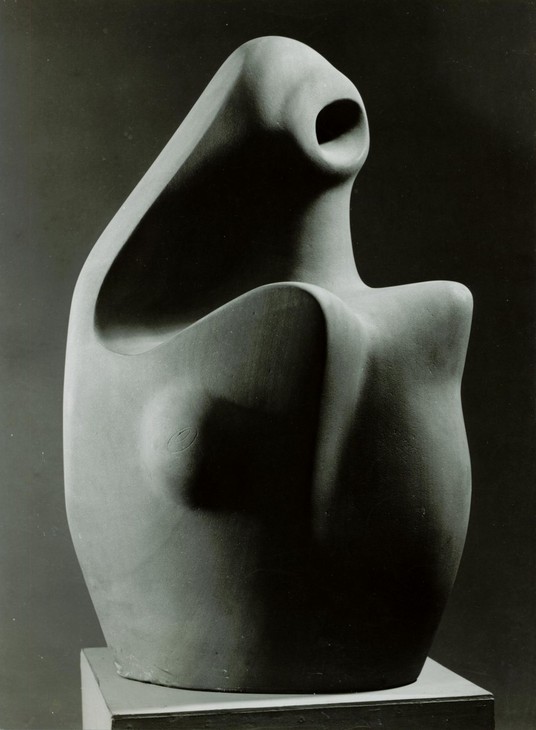
Henry Moore
Figure 1933
© The Henry Moore Foundation. All rights reserved
Photo: Henry Moore Foundation Archive
Fig.2
Henry Moore
Figure 1933
© The Henry Moore Foundation. All rights reserved
Photo: Henry Moore Foundation Archive
The sinister orifice is the entrance to a cave, a navel, a sexual image, all-seeing eye and all-devouring mouth. The curved back is uterus and egg, symbols of fertility and eternity. The protrusions at the front are breasts and wings. The sum of the parts is not human at all, but a boulder washed by the sea, a dinosaurian creature and a monstrous inhabitant of the moon. Inverted, however, it becomes a female torso, with unambiguous abdomen and breasts.23
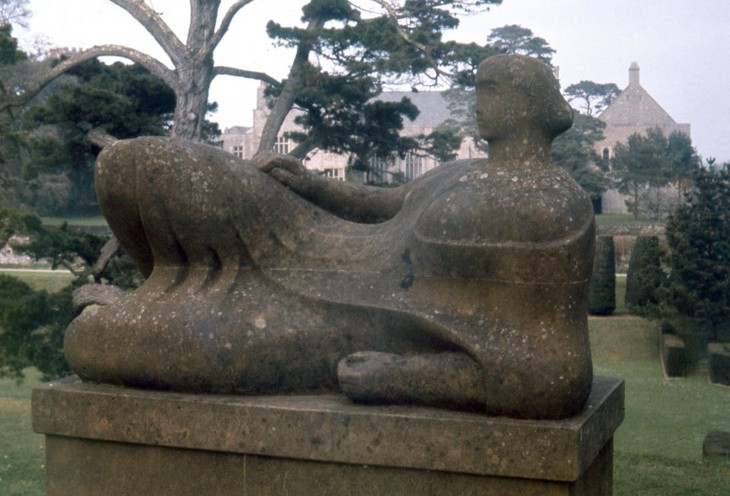
Henry Moore
Reclining Figure 1945–6
Dartington Hall, Devon
© The Henry Moore Foundation. All rights reserved
Photo: The Henry Moore Foundation archive
Fig.3
Henry Moore
Reclining Figure 1945–6
Dartington Hall, Devon
© The Henry Moore Foundation. All rights reserved
Photo: The Henry Moore Foundation archive
The Reclining Figure, like the sacrificed and resurrected god of a fertility-rite, is at once skeletal and alive, prone in burial and flowering into new life, dug into the earth to be explored like the caves in a cliff or the hollows in a fallen tree and bursting with energy in every deflection of a rhythm, reinforced by the grain, moving perpetually along the length of the figure and into and around its depth. The chest, a heart twice eroded where slotted by wide apertures, is made by this rupture of convex by concave to inhale and exhale the light. Sexuality is imaged in the huge thighs, the tense, thrusting crotch between them, and the holes at the back which admit light to push the thighs apart. The shape of the crotch is repeated again and again, lengthways and depthways – even in the space between the feet, for the calves, bent back at right-angles to the thighs, are themselves thighs, and the feet a pelvis.26
Although it included such eloquent set-piece accounts of specific works, the Burlington article generally adopted a scholarly tone and argumentative rigour that contrasted with Sylvester’s other texts of the period, aimed at a wider public or readership. Thus, 1948 also marked the start of Sylvester’s curatorial engagement with Moore’s work. A show of drawings had its origins in Moore being approached by two students at the University of Cambridge to lend works for a show.27 The artist subsequently offered the works to the Arts Council as a touring exhibition. Sylvester’s long relationship with that body began with the brief introductory text in the catalogue, in which he highlighted Moore’s pervasive concern with ‘massiveness’, and sought to characterise the ‘poetic feeling that informs Moore’s interpretations of the human figure’ as ‘a sense of mystery and time-lessness’:
A boulder-like massiveness makes woman appear ‘older than the rocks’, presents us with an intimation of eternity. A bone-like tension recalls ‘the skull beneath the skin’, scattered bones in endless desert. A hollow or a hole evokes the mystery of the cave and of the womb. These are the variations; the theme is the relationship of man to the earth.28
Sylvester subsequently wrote the introductory essay for a sculpture and drawings show staged in 1949 in Wakefield and Manchester. Here he sought to clarify for himself, and convey to others, the content and expressive purpose of ambiguity in Moore’s art, a lasting preoccupation in his writings on the sculptor and on art in general:
What if the ambiguity is part of the message? It is surely significant that not all Moore’s works are difficult to understand. And if we look at those that are – that is, if we really do look at them – I think we shall find that they are ambiguous and strange because they are telling us about something strange, because their message is that nature is not as simple as she appears.
Surely the artist is there to do something more than merely provide us with a stimulus to use our own imagination? – the sort of stimulus we find in a cloud or in shadow cast on a wall. Moore does do something more. His images can be interpreted in any number of different ways, evoking for each of us a host of different things so that no two persons’ lists of evocations will tally. But it is precisely by representing a multiplicity of things that Moore tells us what he thinks and feels about those things ... And it is not in spite of but because of the ambiguity of his forms that he communicates those definite feelings: ambiguity is itself the means of communication. For if a sculptural form can signify more than one thing, this shows that there is a relationship between the different things it signifies – between eye and navel, between breast and mountain. Moore also tells us something by carving stones as erosion carves pebbles, cliffs and boulders, by forming wood in rhythms like those of a tree, by shaping metal in the image of bones – which resemble metal in that they are tense and brittle – that is, by imitating nature’s way of working materials similar to those he is using ... Moore tells us that in stones on some forgotten shore is the seed of the form of man; that the human and the monstrous and the inanimate are all manifestations of the same life principle; that, if no woman had ever lived, the curve of a woman’s breast would have been moulded by the sea; that man will petrify and stones arise in a slow process of awakening; that man is both offspring and ancestor of the earth.
He has been a member of the Surrealist movement and his vision is characteristically surrealist in that he surveys existence with wonder and inquietude, interprets it as metamorphosis – not of one thing into others only but of life into death and death into life ... In Moore’s world, flux and endurance co-exist. There, if all is flux, it is a slowly moving change in things that resist change and aspire to permanence. Moore conceives of change as a process consummated only across centuries: not in the rapid succession of seasons, the quick growth and decay of animals and plants, but in slow erosion by wind and by water of pebbles and cliffs and rocks. His art is a revelation of the life of stone.29
He has been a member of the Surrealist movement and his vision is characteristically surrealist in that he surveys existence with wonder and inquietude, interprets it as metamorphosis – not of one thing into others only but of life into death and death into life ... In Moore’s world, flux and endurance co-exist. There, if all is flux, it is a slowly moving change in things that resist change and aspire to permanence. Moore conceives of change as a process consummated only across centuries: not in the rapid succession of seasons, the quick growth and decay of animals and plants, but in slow erosion by wind and by water of pebbles and cliffs and rocks. His art is a revelation of the life of stone.29
Such views can be seen to reflect a pantheistic sensibility characteristic of 1940s ‘neo-romanticism’ in Britain. We might recall that Sylvester was also immersed at this time in the poetry of Dylan Thomas, whose memorable poem began with the lines: ‘The force that through the green fuse drives the flower/Drives my green age; that blasts the roots of trees/Is my destroyer’.30
Sylvester’s initial phase of immersion in Moore’s work culminated in curating the major retrospective at the Tate Gallery in 1951, a show timed to coincide with the Festival of Britain. This was another commission from the Arts Council, and for Sylvester a key determinant of his sense of curatorial vocation: ‘By the turn of 1950–51, as I sat in London working out the lay-out for the Moore retrospective, I had crystallised an idea of what sort of work I thought I could do adequately from now on’.31 The catalogue (corresponding to the display) began with a selection of drawings of figures and natural objects, which served to indicate ‘The Foundations of Moore’s Art’ and ‘the essential peculiarity of the language of Moore’s more abstract work’. In contrast to the cubists or Klee, Moore’s goal is not ‘formal invention’:
When Moore distorts the object he is representing, it is because he has replaced some parts of that object with representatives of other objects: his images are the product, but of invention, but of substitution ... Moore’s alterations of appearances are simply metaphors. This obsession with equivalences, correspondences, reveals an affinity with the preoccupations of the Surrealists. Moore differs from them, however, in one essential respect – that their substitutions or transplantations are intended to be outlandish, whereas he would wish his to appear perfectly natural and inevitable ... Now the importance for Moore of pebbles, bones, shells etc, becomes clear. He needs a vocabulary of natural forms to substitute for certain forms of the human figure.32
The argument about Moore’s fundamental aesthetic impulse served as an antidote for Sylvester to the familiar line that the character of the sculptures was rooted in their ‘truth to materials’ – the notion that ‘he has sought to employ “forms natural to the material he is working in”’. This may have some application, Sylvester indicated, to the stone sculptures: ‘But his wood sculptures do not, in general, reveal a striking resemblance to tree forms. Moreover, it is difficult to see what forms are ‘natural’ to concrete and terra-cotta, lead and bronze’. The seven subsequent sections of the show and catalogue combined sculpture and drawings to describe the chronological evolution of Moore’s art, and its shifting points of departure in ‘primitive’ and modern sculpture, along the lines of his account in the Burlington Magazine.
The context of the 1951 catalogue dictated an affirmative rhetoric, but in private, as we have seen, Sylvester was starting to experience reservations. He had cut his critical teeth on Moore but thereafter sought to acquire a fuller knowledge and understanding of modern sculpture generally through reading and above all through looking at work and talking to artists in both Paris and London. This more cosmopolitan awareness naturally affected his perspective on Moore. One of his problems, already encountered, was how to deal with Moore’s evident affinities with elements in the wider trajectory of modernist sculpture in Europe. What was it that absolved Moore from the charge of being unoriginal, if not positively derivative, and merely a big fish perhaps in the small pool that was British modernism? Then there was the issue of Moore’s unevenness. A more sceptical tone appeared as early as 1948. In his response to a show of drawings and preparatory models at the Roland, Browse and Delbanco gallery, he observed of Moore: ‘it was only in 1940 that he began to use a naturalistic idiom in drawings designed as finished works of art. Many of these have been rather too obviously monumental, sweet in vision, uninteresting in composition and wooden in form’.33 He further noted that ‘since 1938, Moore has frequently drawn figures in an imaginary setting or landscape, but the relationship between the personages and their surroundings always seemed to me arbitrary and rather meaningless’.34
An additional challenge, for Sylvester, was how to respond to Moore’s ongoing reinvention of his art, as the artist built upon his existing achievements and concerns but also, to some degree, explored novel imagery, materials and techniques (notably bronze casting), formal possibilities and methods of generating sculptural compositions. Such shifts within Moore’s art, however modest compared to the restlessness and ambition of a figure like Picasso, were a product of the artist’s impulse to keep pushing himself and not to stand still. But Moore also found himself taking account of and adapting to new opportunities, as he became increasingly successful in terms of exhibitions, sales and large-scale public commissions.
For Sylvester and other critics, this produced the issue of how to evaluate the work of a sculptor who seemed to be increasingly identified with the artistic and social ‘establishment’, and who was no doubt regarded by other artists the critic knew and admired, of his own and then younger generations, as in essence an old-fashioned and over-rated figure, whose work it was necessary vehemently to reject, as a precondition for individual or collective progress. He was exposed early on to this generational antipathy. In a letter of 1965 Sylvester emphasised that the current climate of opinion was not so new as was generally assumed. He recalled that the reaction against Moore did not start with Anthony Caro, but rather ‘began about 1946–7 with Paolozzi and Turnbull and Raymond Mason’:
They were very strongly anti-Moore, very strongly pro-Giacometti. They were already anti-Moore before they found out about Giacometti, and when they did find out about him when they were in Paris in 1947 onwards, they started using him as a stick to beat Moore with. The great document of the period was the catalogue of the 1948 Giacometti exhibition at the Pierre Matisse Gallery in New York ... Then there was Butler. I first met him when he was working at Henry’s helping to carve the Three Standing Figures ... He was now just beginning to do his iron sculptures. I frequently visited him at that time (I even took Paolozzi there) and we used to spend hours and hours talking about Moore, and most of what Butler had to say was critical – that is on his position rather than his talent, but his moral as well as aesthetic position. He too was extremely interested in Giacometti. And of course he was very interested in Gonzalez. So for that matter was Paolozzi and perhaps Turnbull ... Gonzalez was the great find of the period among recently past artists ... And Paolozzi was busy discovering Duchamp. All in all I would say that the atmosphere was more virulently anti-Moore then than it is now.35
Such conversations doubtless informed the essay ‘Contemporary Sculpture’, which appeared in 1951 in the Listener. This indicated Sylvester’s didactic impulse to convey to wider audiences the more sophisticated grasp he himself now possessed of the current aesthetic climate and its historical background. The main springboard for the article was the emergent new British sculpture. Discussion of significant younger figures, however, was preceded by an outline, in characteristically confident terms, of ‘the four conceptions which have given rise to the principle developments in twentieth-century sculpture’, conceptions associated, to Sylvester’s mind, with cubism, Brancusi, surrealism and, finally, Giacometti’s ‘articulation of the human figure in space’, extending from his surrealist work through to the more recent modelled, figurative sculptures.36 The first three of these were seen as having shaped the ‘superstructure’ of Moore’s art, even though its deeper foundations are in ‘the medieval effigies in Yorkshire churches, the frescoes of Masaccio, and, above all, the Aztec idol called the Chac-mool’.37 Moore emerged from this analysis, according to Sylvester, looking an ‘extremely eclectic artist’, who had ‘never been a great formal innovator’.38 For that reason, ‘the most interesting of our younger sculptures are those who have reacted against Moore’, which brings him at last to the sculptural innovations of such figures as Butler and Paolozzi, the most fully-formed and promising of the younger generation, and sculptors for whom post-war Giacometti was a compelling inspiration, as increasingly his work was for Sylvester himself. The critic recalled this intruding on his relationship with Moore: ‘our arguments became increasingly edgy and, while I tried to restrict my actual allusions to Giacometti, Henry knew what was going on. He even said that one day I’d turn against Giacometti’.39
For the next few years Sylvester struggled with his ambivalence. The two contrasting works by Moore installed in relation to the Time and Life building in Bond Street in London epitomised the artist’s unmistakeable tendency since 1945 to ‘move freely’ between more naturalistic and more abstract idioms.40 The decorative screen facing Bond Street comprises four stone carvings, silhouetted within openings, that for Sylvester looked back directly to work from the mid-1930s but ended up looking ‘rather tamed and urbane’ by comparison with their ‘grimmer and more mysterious forbears’; they were ‘disappointingly unimpressive’ and ‘incongruously neat’.41 The conception was ‘an ingenious solution to the difficult problem Moore had to contend with’ but in practice the forms also looked dwarfed by their architectural setting, and might have benefited from the use of a contrasting colour or material.42 Yet the Time-Life Reclining Figure was ‘probably the finest thing that Moore has done since the outbreak of the war’43 and ‘a perfectly integrated work ... possibly the most lyrical of all Moore’s larger statues, largely because of the lovely treatment of drapery’, patently inspired by the Elgin marbles.44 Such comments indicate that Sylvester’s judgements were not necessarily governed by how superficially progressive a given work might look, in formal terms. More generally, however, he was disconcerted by the apparent ‘split’ currently in Moore’s ‘aesthetic personality’. ‘On the one hand, he is capitalizing on ideas he first explored between ten and twenty years ago, with an immense professional competence. On the other hand, he is working on problems more strange to him in a way that is halting and uncertain and prone to error’.45 In principle, it was this latter aspect – Moore’s more experimental and risk-taking side – that Sylvester found the more interesting and attractive.
A show of Moore’s recent sculpture and early drawings at the Leicester Galleries in 1955 prompted Sylvester to comment in a more focused way on the role of scale and its relationship to spectator engagement. The mutual adjustment of physical scale to sculptural idea had always been a key concern for Moore himself but whereas earlier carvings had existed only on one scale, newer works might exist three-dimensionally as maquettes, now sometimes case in bronze, and in more than one state of enlargement, a process which could well involve significant adjustments to a work’s form and even materials. The exhibition under review demonstrated to Sylvester why certain ideas were most effectively realised on a monumental scale. The show was ‘dominated by two enormous sculptures of which we have already seen versions on a scale to fit the drawing-room, and which are incomparably more successful when they are big. This is due primarily to the fact that the point of these sculptures resides in their being hollowed-out to form a womb-like cavity, and that only when they are larger than life – larger than us – are we able to fit ourselves in imagination into these cavities, which now really are capable of containing us’.46 But Sylvester also agonised over the relationship of these new works, however bold and involving, to Moore’s existing oeuvre: ‘If there is a criticism to be made of these two sculptures [Upright Exterior and Interior Form and Reclining Exterior Form] it is that they are really only an elaboration of formal ideas which Moore first explored in the late nineteen-thirties ... It is not easy for any artist, least of all an artist of Moore’s wide-ranging mind, to sustain over a period of twenty years the imaginative impetus and intensity that that an idea is charged with when it is first conceived’.47 The most convincing exhibit, in Sylvester’s eyes, was a smaller piece, Reclining Figure, which nonetheless posed related problems:
The conflict between structure and representation has been solved. The work is resplendent with exciting echoes and contrasts of shapes, considered as shapes. But this play of shapes does not conceal or congeal the reality of the human body: it concentrates that reality, it sharpens it. It is precisely because Moore can now resolve these complex problems that he cannot be expected to produce the same intensity of feeling as before in dealing with simpler ones.48
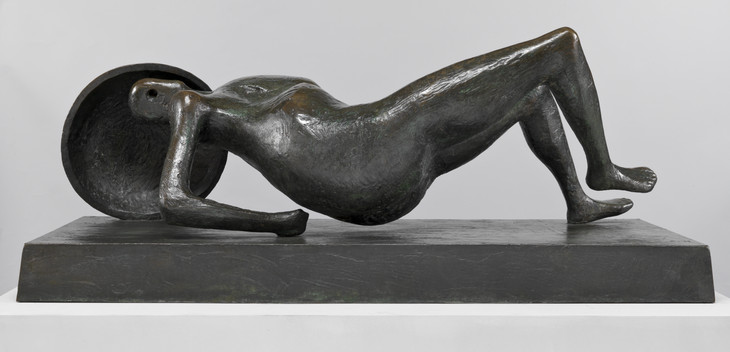
Henry Moore OM, CH 1898–1986
Falling Warrior 1956–7, cast c.1957–60
Bronze
object: 650 x 1540 x 850 mm
Tate T02278
Presented by the artist 1978
© The Henry Moore Foundation. All Rights Reserved
Fig.4
Henry Moore OM, CH
Falling Warrior 1956–7, cast c.1957–60
Tate T02278
© The Henry Moore Foundation. All Rights Reserved
If Sylvester had been notably hesitant about the work of the 1950s, with its divergent, even contradictory directions, in the following decade he appears to have become a more committed advocate again, in response to fresh departures in Moore’s art and its newly rugged and expressive quality. The Whitechapel Art Gallery’s 1960 exhibition of Moore’s art over the past decade provided Sylvester with the opportunity to take stock. He was conscious of diverse strands of work (the biomorphic, the humanistic and the contorted) in which a particular stylistic language correlated with certain moods. Yet each seemed incomplete or in its own way limited. Moore now seemed to be overcoming that separating out of his aesthetic impulses:
In at least three big sculptures, all of them recent ... he has succeeded superbly in achieving an integration of his styles. Sculpturally, these are the strongest, grandest things he has done; and in content they bring together, oppose and resolve all the several kinds of experience which in the other works exist in isolation. The two-piece figures reiterate his familiar metaphor of woman-as-landscape, but are at once more landscape and more woman than before – just to touch on one of the many ways in which these are the most richly contradictory and therefore the most rich of Moore’s sculptures.51
Sylvester’s renewed belief in Moore comes through strongly in the review: ‘At the outset of the period covered by this exhibition, Moore seemed to many of his admirers to have his best work behind him. He has more than recovered, and it is inspiring and moving to find that sculptor labouring under the disadvantages of being an English artist, and a national hero and an international success, is in his sixties doing his finest work’.52 Moreover, the usual reading of Moore as a benign, even banal, humanist seemed wide of the mark. For Sylvester, his ‘deeper feelings are concerned with less peaceful areas of experience’. A similar enthusiasm comes across in a subsequent review of Moore’s early carvings at the New London Gallery. The works ‘look better than ever’, and Moore emerged, in Sylvester’s view, as ‘the finest sculptor in stone of modern times’.53
Sylvester’s interview with Moore appeared in summer 1963, broadcast on the radio and published in transcript both in the Listener and in the catalogue of Moore’s show at the Marlborough Gallery.54 It may be that Sylvester knew the artist well enough not to probe him about the imaginative meanings or emotional charge of his work. At any rate, the questioning focused mainly on how the more recent works were made: his approach to bronze casting and patination, as an alternative aesthetic to carving; the shift from using drawings to working with found natural objects and small maquettes as the means to generating sculptural forms; the practicalities of making large works for outdoor settings; the differences, for Moore, between the recent two- and three- piece reclining figures. The conversation is of course richly informative, and brings out the bluff pragmatism of Moore’s artistic persona. But it is also slightly flat compared with Sylvester’s interviews with other artists more invested in the mysteries and drama of the creative process. Another conversation focussing on Moore’s love for the sculpture of Michelangelo, especially the late Rondanini Pietà, appeared the following year in the Sunday Times Magazine, and was subsequently reprinted in the New York Times magazine and elsewhere.55

Henry Moore with David Sylvester at the Tate Gallery 1968
Photo: © Martine Franck/Magnum Photos
Fig.5
Henry Moore with David Sylvester at the Tate Gallery 1968
Photo: © Martine Franck/Magnum Photos
A summary description of his themes may help to elucidate Sylvester’s underlying purpose in the 1968 volume. The sequence starts, predictably enough, with two core strands of imagery, the reclining figure and the mother and child. The former permitted Moore, according to Sylvester, to combine seemingly contradictory overtones. The sculptures are literally female, but also masculine in their pent-up energy, and overall they evade the erotic connotations that the subject often possessed. They combine human imagery with landscape forms that testify to the power of natural forces, the monumental formations of mountains, for example, and the mysterious openings of caves. The images are potentially active, but they might also evoke deathly themes, such as slab and sarcophagus. Formally speaking, reclining figures are, in Moore’s own words, ‘free and stable at the same time’, and they combine a certain balance in the massing of form with an emphatic asymmetry from most viewpoints.61 Sylvester devoted a good half of this essay to arguing that reclining figures allowed Moore to bring together allusions to the blocky stylisations of ancient Mexican carvings, such as the famous Chacmool, Moore’s distinctive variant on the wider ‘primitivism’ of the period, and an engagement with the more animated type associated with Mediterranean classicism, which Moore had encountered on his trip to Italy in 1925. The sculptor himself could not acknowledge this European inspiration until the wartime shelter drawings, but Sylvester was surely right to state that the interplay between what might have seemed aesthetic opposites had actually been present in his practice from the late 1920s onwards.62 The mother and child theme is likewise found to be present in Moore’s work from the beginning, and like the reclining figure it ‘suited his desire for asymmetry and a complex interaction of contrasting masses’.63 It became more abstract and metaphorically ambiguous in works like Two Forms 1934 (Museum of Modern Art, New York) and in several works from the early 1950s through to Mother and Child 1967 (Henry Moore Foundation). In between came the more illustrative shelter drawings and, above all, the Northampton Madonna and Child, in which Moore was able to engage with Italian Renaissance models such as the long-admired Virgin and Child Enthroned by Masaccio (National Gallery, London).
Subsequent sections addressed continuities and shifts in relation to form and working method. The notion of ‘Correspondences’, Moore’s own term for visual metaphors alluding to multiple life forms in a single composition, allowed Sylvester once again to span the decades and also to situate the sculptor within the kinds of modernist artistic language, predominantly aligned to surrealism, that had formed and stimulated Moore’s aesthetic, and at the same time to characterise his distinctive sensibility. On the basis of a series of astute comparisons, he concluded more broadly that Moore, ‘like Picasso, is an anthropocentric artist, which Arp, like Brancusi, is expressly not’.64 Conversely, Moore’s art was totally unlike Picasso’s ‘in its absence of wit, of the sharply incongruous image: Moore’s metamorphic forms reveal marvellous and unsuspected likenesses between disparate things, but the revelation is like that of some elemental truth ... it seems right and natural, reasonable, not outlandish and questionable’.65 But that ‘rightness’ accommodated an interplay between divergent readings, as the viewer contemplated a specific work and moves around it: ‘If there is one constant which distinguishes Moore’s language of biomorphic forms from those of his contemporaries, it probably lies in the coincidence of landscape with oral and genital references. The human body becomes at the same time its own most secret parts and a part of its elementary environment’.66 Such passages highlight the element of recycling in the book, with Sylvester drawing on his critical writings from twenty years previously. Now, however, an emphasis on bodily and specifically sexual imagery inherent in the experience of Moore’s sculpture is an especially striking feature of Sylvester’s commentary. In this section, he talks about the isolation, magnification and displacement of parts of the body, most commonly the mouth and the genitals:
The female genitals are imaged frequently, in abstractions such as the rose aurora Three Rings and the Pynkado wood Two Forms, and in the tunnelled forms of reclining figures: they are precisely imaged; it is not at all a matter of indiscriminately seeing holes as sexual symbols. Phallic imagery occurs mostly in sculptures of the last ten years. The phallus never appears as an isolated image ... but only in conjunction with forms that signify the female. It rears up in front of her, burrows into her, is enclosed within her, displaces a part of her. But there is no more powerful embodiment of sexual confrontation in Moore’s work than one presenting no such specific imagery the Two Forms of 1966, which are like two thrusting pelvises facing each other.67
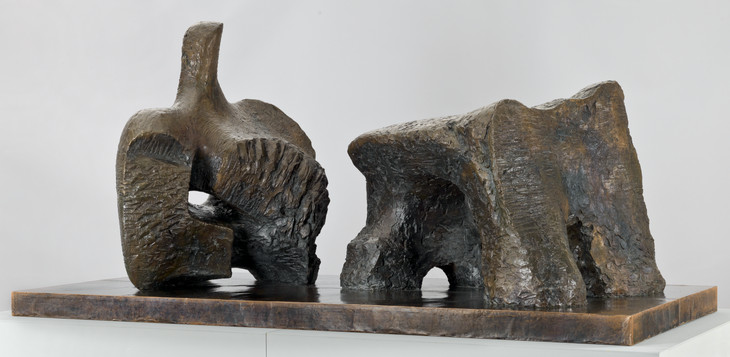
Henry Moore OM, CH 1898–1986
Two Piece Reclining Figure No.2 1960, cast 1961–2
Bronze
object: 1250 x 2900 x 1375 mm
Tate T00395
Purchased 1960
© The Henry Moore Foundation. All Rights Reserved
Fig.6
Henry Moore OM, CH
Two Piece Reclining Figure No.2 1960, cast 1961–2
Tate T00395
© The Henry Moore Foundation. All Rights Reserved
The general argument about metamorphic form is followed by a more specific discussion of ‘Stones, Bones, and Shells’, focusing on Moore’s use of found forms as springboards to creativity. Here Sylvester analysed the varying degrees to which the sculptor modified his points of departure, and also how he homed in on different kinds of found object in accordance with his own shifting sculptural concerns and material preferences. Thus smooth, worn pebbles were a key inspiration in the early 1930s, whereas, after the mid-1950s, he abandoned drawing and began developing ideas by using sketch-models that were commonly based on found objects, now the ‘rougher, more irregular forms’ of flints and butchered bones. Aside from their role in provoking formal invention, the use of found objects reinforced Moore’s ambition to root his art in reality. Moore’s theoretical advocacy of ‘truth to materials’ seemed at one stage to anchor his art in something objective and external to mere imagination. In the same way Sylvester posited a connection between Moore’s emphasis on psychological meaning in his work, as opposed to its providing escapist satisfactions or mere formal interest, and saw his constant recourse to natural points of departure as reinforcing ‘a need to tell himself that his abstract forms were obeying some authority beyond that of his own instincts – were therefore not arbitrary, not products of personal taste or fantasy, but were sanctioned by nature’.70 Moreover, small-scale natural objects could be known intimately, through holding and manipulation in the hand, and to that extent implied a sense of connection with deeper truths. The absence of wilfulness and self-indulgence in Moore’s work could be presented, then, as emblematic of a virtuous moderation, although the artist must surely have been somewhat tarnished, for Sylvester, by a propensity for compromise that he viewed as the constant failing of British modernism.71
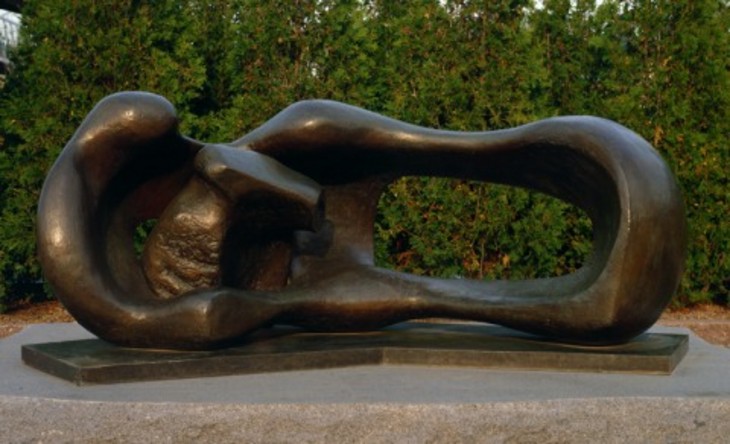
Henry Moore
Reclining Mother and Child 1960–1
© The Henry Moore Foundation. All rights reserved
Fig.7
Henry Moore
Reclining Mother and Child 1960–1
© The Henry Moore Foundation. All rights reserved
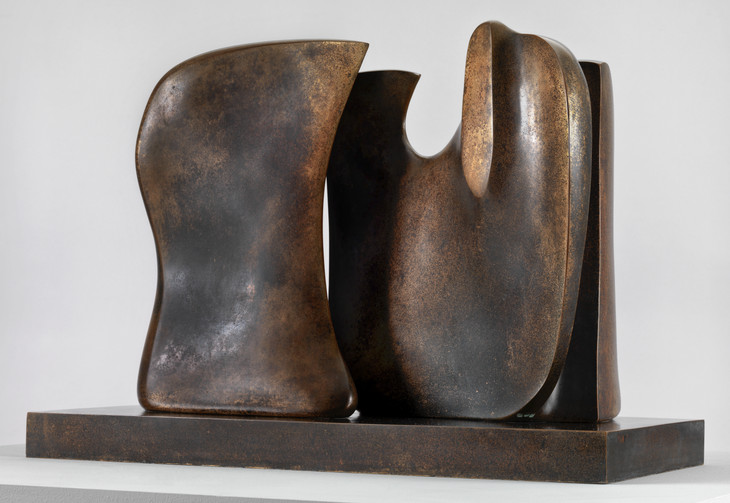
Henry Moore OM, CH 1898–1986
Working Model for Knife-Edge Two-Piece 1962
Bronze
object: 498 x 711 x 330 mm
Tate T00603
Purchased 1963
© The Henry Moore Foundation, All Rights Reserved, DACS 2014
Fig.8
Henry Moore OM, CH
Working Model for Knife-Edge Two-Piece 1962
Tate T00603
© The Henry Moore Foundation, All Rights Reserved, DACS 2014
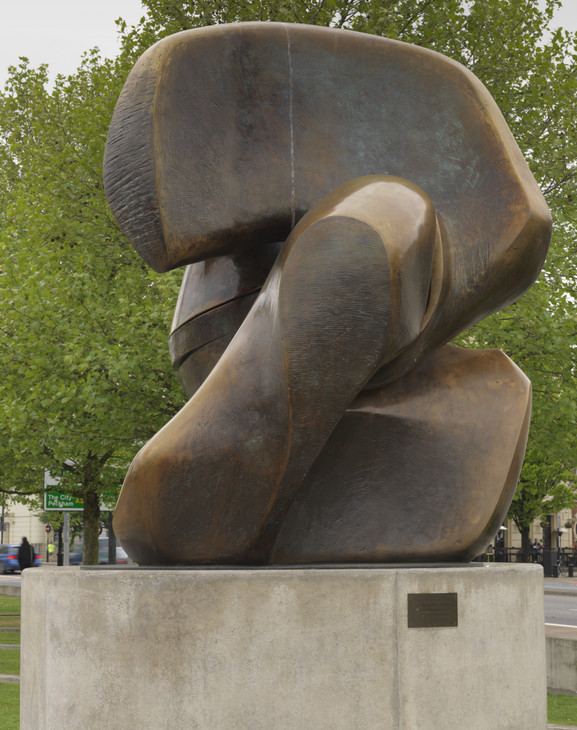
Henry Moore OM, CH 1898–1986
Locking Piece 1963–4, cast c.1964–7
Bronze
object: 2920 x 2800 x 2300 mm
Tate T02293
Presented by the artist 1978
© The Henry Moore Foundation. All Rights Reserved
Fig.9
Henry Moore OM, CH
Locking Piece 1963–4, cast c.1964–7
Tate T02293
© The Henry Moore Foundation. All Rights Reserved
Sylvester’s 1968 book-cum-catalogue remains an effective and evocative primer on Moore’s art, offering a compelling reading of the combined consistency and diversity evident within the artist’s extensive oeuvre. The advantage of the thematic approach was precisely that it enabled Sylvester to sidestep the familiar narrative of Moore’s technical evolution from carving and ‘truth to materials’ through to working with plaster and bronze; or his stylistic evolution from primitivist and monumental to a more open and sometimes classicisising idiom. Implicit in the overall sequence of the themes there was a sense of Moore’s development, as a more sophisticated reader would grasp. Sylvester consistently emphasised the recurrence of Moore’s thematic and formal preferences, from their first emergence through to their most recent reinterpretation. In conceiving the study in this fashion, one might also say that Sylvester was playing not only to Moore’s consistency but also to his own critical strengths. The structure enabled him to concentrate on the work, and not to get bogged down in biography, context and career. Sylvester was in essence a brilliant journalist, who excelled at the short essay format, but clearly struggled with texts on a larger scale, which could cause him torment and take forever to bring to a state such that he could let go.81 Even when realised, such projects sometimes ended up as slightly unsatisfactory accumulations of fragmentary essay-like chapters, at the expense of overall argument.82 In the case of Moore, Sylvester found a way of compiling a study comprising highly focused, self-contained vignettes which is also coherent as a whole and cumulatively persuasive. Anyone wanting a more straightforward, chronological survey of the life and art could turn to John Russell’s book, published by Penguin in 1968 to accompany the show, which Sylvester doubtless knew was on its way.83 He sought instead to characterise the art, and to cut through to what seemed fundamental and enduring, rather than circumstantial, in Moore’s work. As he later remarked: ‘I took this as an opportunity to isolate what I thought was his really creative output – a task made possible by his [Moore’s] generous non-interference in the selection’.84 Critical reaction to the exhibition itself, which were generally very positive, tended to subsume assessments of the publication. However, the review in the New York Times probably referred to both in noting that Sylvester ‘has been tough on Moore, and made Moore look all the tougher himself as a result. Great chunks of the sculptor’s more easy, humanist side – the side which probably endears him to his widest audience – have just been left out ... the critical point is being made that his greatness lies in his form invention and in a kind of imagery too complex, too essentially ambiguous at its most energetic, ever to be reassuring as straightforward humanism’.85
The fundamentals that Sylvester sought to capture through his thematic account were not just stylistic but also, one might say, existential. There is no attempt to psychoanalyse Moore as a private individual, as others had and have attempted, but there is a clear assumption in his reading of Moore that the way we read and respond to artworks aesthetically is rooted in profound and even universal psychic impulses, which inevitably include bodily awareness and sexual desires, states of mind that, if we give them free rein, matter as much as any art historical knowledge in determining how and what we perceive in works of art, especially when they are images of the figure. In that sense, one could argue that Moore was serving as a case study for a general theory of the nature of art, a theory, however, which is nowhere acknowledged except in the book’s inconspicuous dedication: ‘To Adrian Stokes’. We know that the two men were good friends, but more research is needed to assess the inspiration Sylvester derived from Stokes’ verbally and conceptually dense writings, highly revered at the more intellectual end of the London art world, and that he translated into the more accessible terms of his own essays for magazines and exhibition catalogues, of which Stokes in turn was a keen admirer.86 The dedication surely implies that Sylvester’s understanding of Moore had been enriched by their conversation, and by Sylvester’s immersion in Stokes’s work, especially recent books such as Painting and the Inner World (1961) and The Invitation in Art (1965). In a review of Three Essays on the Painting of our Time (1961), Sylvester described what he valued in Stokes’s writing and clearly aspired to in his own, not least in his evaluations of Moore:
He refuses to dismember the experience he is writing about, makes the several elements which co-exist in the experience co-exist in the writing. He draws no clear distinction between physical description of the work and discussion of the spectator’s response to it. Again, when the overt topic is subject-matter, he seems really to be talking about style, and when the overt topic is style, seems really to be talking about subject-matter. This perpetual inter-relating of form and meaning is linked to an extraordinary imaginative insight into the reciprocal flow between art and life, what I mean by ‘life’ being ... enduring human habits and needs and gestures and other commonplace phenomena which others take so much for granted that their relevance remains unnoticed.87
Such books by Stokes, steeped as they are in the psychoanalytical theories of Sigmund Freud and his English follower Melanie Klein, endeavour to describe how involuntary projection of the inner world enters not just into the making but also into the perception of art works. This applies as much to the way we read artistic form, so extending the discussion to architecture, as the subject matter embedded within form. Stokes’s own application of this methodology to characterising the work of individual artists, such as Michelangelo and J.M.W. Turner, was perhaps Sylvester’s model in constructing an account of Moore. It is notable that when Sylvester wrote an essay in 1988 about Stokes, whom he numbered in the category of ‘great writers on art’, he cited the following passage from The Invitation in Art as one of the ‘most potent’ and as representative of ‘the spirited metaphor, the mordant wit, the shockingness ... the celebration of unconscious fantasy, the constant awareness of the drama of bodily functions, the Pateresque preciosity of language, the rich variety of intricate rhythm’ that he so admired in Stokes:
To put the matter the other way round: how Gothic is the female genital. Think of the pointed arches, fold within fold, of a cathedral door, of turret slits and narrow apertures. We pass into vaulted chambers of a foliate if chastened exuberance. But more than plants, the animal, animal function sustains this soaring, religious style etc.88
Stokes’s psychoanalytically-based aesthetic at the very least reinforced Sylvester’s emphasis on bodily, often directly sexual, experience, as one of the most distinctive and most powerful sensations that Moore’s sculpture could provide. Chris Stephens, curator of the major 2010 Moore exhibition at Tate Britain, has noted that the 1968 book provides ‘an important and rare discussion’ of the role of sexual imagery in Moore’s art.89 It is worth considering whether this may also have seemed an especially effective way of presenting the artist at the particular moment. Sylvester’s show and book were, inevitably, an exercise in defending and recuperating Moore’s art at a time when it was looking all too safe and ‘establishment’ to many viewers. Only the previous year a large group of younger artists had protested in a letter to the Times newspaper at the idea that the Tate Gallery might acquire an extension with a permanent display given over to Moore, who wanted to donate works.90 In their own work, such artists explicitly and often dismissively rejected Moore’s artistic example. Presumably the Tate Gallery, the Arts Council, and Sylvester himself might not, ideally, have chosen to stage a big Moore exhibition in the year that was to become a by-word for revolutionary zeal, in the forms of student protest against the Vietnam war and general establishment and capitalist oppression, not to mention sex, drugs and rock and roll, the Soviet invasion of Czechoslovakia, and in the art world the heady flowering of land art, conceptual art, performance art and so forth. Roy Lichtenstein, the artist featured in the preceding exhibition at the Tate Gallery, may have looked more in tune with the iconoclastic mood of the moment but even Pop Art was starting to look old hat.
The actual springboard for the show was, of course, the simple fact that 1968 was Henry Moore’s seventieth birthday. This circumstance was mentioned in Gabriel White’s ‘Foreword’, but it was nowhere alluded to in Sylvester’s text, unless the numerate reader chose to work it out from the chronology. Doubtless Moore himself did not want to come across as an old man, getting his dues. It may be that Sylvester and the other organisers wished to play down any air of reverence for an elder statesman, at a time when experimental youth culture was so much in the air. At any rate, Sylvester’s book might be thought to betray other signs of an impulse to ‘package’ Moore as best he could in line with contemporary preoccupations. For instance, it does its best to ignore the growing sense that Moore had ‘sold out’ and was churning out banal, repetitive reclining figures for the civic plazas that were cropping up all across the affluent world. Again, one could only glean information about such commissions from the chronology, and the siting of work is conspicuously absent from the themes Sylvester selected, even though sculpture in outdoor settings was another kind of continuity between the 1930s and Moore’s current production. The shelter and other war drawings barely featured in the book, except as an element in the drapery section, whereas they tend now to be central to our understanding of Moore.91 The material and formal language of Moore’s work might have been for many relics of a bygone modernist era, but Sylvester possibly calculated that bringing out the sexual content of the sculpture was one way to secure its resonance for current viewers. Alternatively, one could argue that the liberated climate of the day encouraged Sylvester to highlight readings that he himself had long been attuned to, but had felt more inhibited previously about articulating to general audiences.92
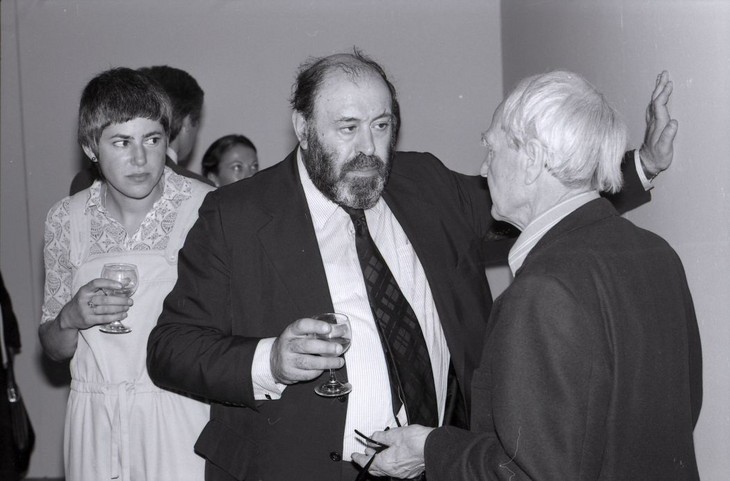
Gemma Levine
David Sylvester (centre) and Henry Moore at Moore's eightieth birthday exhibition held in the Serpentine Gallery, London, 29 June 1978
Tate Archive
© Gemma Levine/Tate
Fig.10
Gemma Levine
David Sylvester (centre) and Henry Moore at Moore's eightieth birthday exhibition held in the Serpentine Gallery, London, 29 June 1978
Tate Archive
© Gemma Levine/Tate
Cumulatively, Sylvester’s writings on Moore, however disparate in tone and purpose, add up to an impressively coherent, engaged and, above all, loyal body of criticism. It is difficult to think of a more striking instance of a critic dealing in public with the long-term trajectory of an artist throughout the middle and later decades of his career. By 1950 Sylvester realised that Moore’s most important contribution was behind him, and that the artist was destined to be out of fashion thereafter. One might reasonably observe that, in terms of self-interest, the critic’s association with the increasingly celebrated sculptor yielded a steady stream of invitations to produce texts and to select and curate exhibitions, helping Sylvester sustain what was no doubt a precarious career as freelance critic. Playing the role of Moore’s principal interpreter brought in its train a complex mixture of critical and curatorial opportunities, diplomatic challenge, and financial inducements, whereas in the 1930s the imperative for Herbert Read had, more straightforwardly, been the creation of convincing propaganda for an embattled cause. It no doubt helped that Sylvester was such a visual rather than theory- or ideology-driven critic, who sought as far as possible to judge work on its own terms, rather than in relation to some dogmatic preconception. At any rate, whatever wrong turnings Moore took and debatable attitudes and personality traits he developed as he got older, Sylvester, it seems, continued to believe in his work and in him as an artist. He took Moore’s work seriously when many others were glibly dismissive.
By way of explanation, we might note that Sylvester, more than many critics, had a particular and profound feel for sculpture, reflected also in his writing on Paolozzi, Giacometti, Robert Morris, Richard Serra, Rachel Whiteread and others.99 This sensibility stemmed in large part from the acutely physical, visceral nature of his aesthetic responses. Even more than painting, sculpture demands that the viewer move around the work, and back and forth in relation to it, measuring sensations of form, mass, scale and material, as well as representational imagery, against one another and against how it feels subjectively to inhabit one’s body and to occupy a space. The extremely tactile and figurative emphases of Moore’s art, and its earnest rather than ironic tone, made it especially compatible with Sylvester’s personal preferences as an art lover (the term seems especially appropriate in his case). Moreover, Moore’s work lent itself readily to Sylvester’s preoccupation with ambiguity of form and meaning as a compelling attribute of the most exciting manifestations of modern art. Equally, Sylvester was more alert than most, at the time but also before and since, to the fact that works of art are essentially the product of, and stimulus to, an improvisational process over time, one of making for the artist and then one of contemplation for the spectator. Art, for Sylvester, was fundamentally distinct from legible statement, be it moral, ideological or intellectual. Moore’s germination of ideas through the use of drawings, models, found objects, and variation on well-rehearsed themes, was clearly well matched to Sylvester’s fascination with the making process. The artist’s traditionalism evidently struck a chord too with the critic, whose admiring commentary on other figures, such as Bacon and Giacometti, likewise saw no clash between originality and contemporary resonance, on the one hand, and a highly creative immersion, on the other, in the rich resources of tradition. Finally, although he remained a dedicated follower of ‘the tradition of the new’ throughout the 1950s and 1960s, Sylvester maintained a firm commitment to the varied forms of artistic expression that had emerged in the earlier decades of the twentieth century, especially those broadly associated with surrealism, approaches that continued to underpin the work of an artist like Moore. One might conclude that, whatever the personal rapport and whatever his genuine reservations at times about the work, Moore the artist was rather more Sylvester’s ‘type’ than the aged critic cared to admit to himself.
Notes
See David Sylvester, ‘Curriculum Vitae’, About Modern Art: Critical Essays 1948–97, London 1997, p.30.
These unpublished recollections are to be found among the Moore files in Sylvester’s papers in the Tate Archive and are a valuable resource for reconstructing their relationship. The planned chapter on Moore exists as various drafts but in the end was one of several considered insufficiently resolved to be included in the very brief volume, Memoirs of a Pet Lamb, that was published posthumously (London 2002).
David Sylvester, ‘Chapter IX: Moore’, several typescripts, David Sylvester papers, Tate Archive TGA 200816/5/1/10 and 10 200816/5/1/5/14.
A.D.B. Sylvester, ‘Henry Moore: The Shelter Drawings’, Graphis, March 1946, pp.125–35, 262–3 (English, German and French versions).
Henry Moore, letter to David Sylvester, 1 February 1945, Tate Archive TGA 200816/2/1/711. The article had been sent to Moore by a Mrs Wilson at the National Gallery. Moore also expressed appreciation for Sylvester’s article ‘Neo-Romantic Diction’, which he had read in Counterpoint. Sylvester’s comment comes from ‘Chapter IX: Moore’.
A.D.B. Sylvester, ‘The Evolution of Henry Moore’s Sculpture’, Burlington Magazine, June 1948, pp.158–64 (part 1); July 1948, pp.189–96 (part 2).
The passage quoted by Sylvester about the earlier opening-up of form in wood than stone sculptures comes from Moore, letter to Sylvester, 14 December 1947, Tate Archive TGA 200816/2/1/711).
A.D.B. Sylvester, ‘Foreword’, A Retrospective Exhibition of Drawings by Henry Moore, exhibition catalogue, Arts Council 1948, unpaginated.
A.D.B. Sylvester, ‘The Sculpture and Drawings of Henry Moore’, Henry Moore: Sculpture and Drawings 1923–1948, exhibition catalogue, Wakefield City Art Gallery and Manchester City Art Gallery 1949, unpaginated.
Dylan Thomas is the main subject of Anthony Sylvestre, ‘Neo-Romantic Diction’, Counterpoint, vol.1, 1945, pp.41–5.
[A.D.B.Sylvester], Sculpture and Drawings by Henry Moore, exhibition catalogue, Tate Gallery 1951, p.8.
Ibid. Sylvester reiterated his view in a book review (‘An Anthology of Modern Sculpture’, Listener, 9 July 1953, p.64) and defended his sense of Moore’s roots in response to a typically waspish letter from Douglas Cooper, Listener, 23 July 1953, p.149 and 30 July 1953, p.187.
Ibid. The same concern about ‘inconsistencies of style’ emerged in his review of a 1954 exhibition at the Leicester Galleries (see David Sylvester, ‘Mr Moore’s New Bronzes: An Experimental Phase’, Times, 15 February 1954).
It is worth noting that Falling Warrior was selected for inclusion in Bacon Moore: Flesh and Bone, the 2013 show staged at the Ashmolean Museum, Oxford.
The interview was reprinted in David Sylvester, London Recordings, London 2005, pp.1–17. Recorded 7 June 1963 at Perry Green, and transmitted 14 July 1963. For corrected drafts, see Tate Archive TGA 200816/6/2/1.
Henry Moore, ‘The Michelangelo Vision’, Sunday Times Magazine, 16 February 1964, pp.18–23, reprinted in Alan Wilkinson (ed.), Henry Moore: Writings and Conversations, Aldershot 2002, pp.156–60.
As, famously, in the saga of the Giacometti book that Sylvester laboured over in the 1960s, and which finally appeared as Looking at Giacometti, London 1995.
David Thompson, ‘And a Triumph for Henry Moore’, New York Times, 4 August 1968, section D, p.23. Symptomatically of the changing aesthetic climate, the young Rosalind Krauss commended Sylvester’s historicism in his treatment of Moore but was critical of the failure to bring out the sculptor’s complicity with ideals of ‘possession’ and ‘omniscience’ that were endemic within an outmoded modernist sculpture (‘Book Reviews’, Art Bulletin, September 1970, pp.337–40).
Chris Stephens (ed.), Henry Moore, exhibition catalogue, Tate Britain, London 2010, p.231 (‘Post-War’, note 2).
Sylvester recalled that the sexual resonance of Moore’s work had struck him ‘from the start’ (‘Chapter IX: Moore’).
David Sylvester, ‘Introduction’, Henry Moore at the Serpentine, exhibition catalogue, Serpentine Gallery, London 1978, unpaginated.
Acknowledgements
I am grateful to Jennifer Mundy for the opportunity to collaborate with her and colleagues on the ‘Art Writers in Britain’ research project at Tate, which has provided a stimulating context for thinking about the writings of David Sylvester. An initial version of this paper was presented at the David Sylvester Study Day held under the aegis of the project, an event that produced valuable discussion and feedback. Tate’s engagement with the theme of art writing also led to the award of a studentship, under the AHRC Collaborative Doctoral Partnership scheme, funding doctoral research at the University of Kent on David Sylvester, and I would like to acknowledge the significant and generous input I have received from James Finch, the holder of the award, into the research for this essay.
Martin Hammer is Professor of History of Art at the University of Kent.
How to cite
Martin Hammer, ‘Ambivalence and Ambiguity: David Sylvester on Henry Moore’, in Henry Moore: Sculptural Process and Public Identity, Tate Research Publication, 2015, https://www

